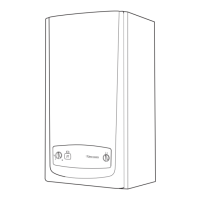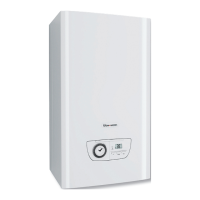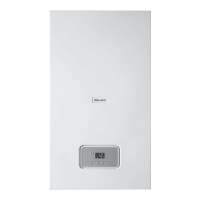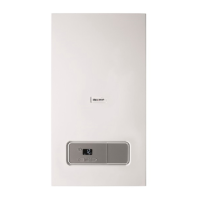Supplied By www.heating spares.co Tel. 0161 620 6677
SECURING
SCREW
SERVICE
FILL LEVEL
CONDENSATE
TRAP
8 Safety Discharge Valve & Condensate Connections
Diagram 8.2
12667
13042
8.1 Safety Discharge Valve
The pipe from the safety discharge valve must not discharge
above an entrance, window or any type of public access area.
Take the short safety discharge tube, union nut and seal,
supplied loose in the boiler fittings pack and fit as shown in
diagram 7.3.
This must be extended, using not less than 15mm o.d. pipe,
to discharge, in a visible position, outside the building, facing
downwards, preferably over a drain.
The pipe must have a continuous fall and be routed to a
position so that any discharge of water, possibly boiling,
or steam cannot create any danger to persons, damage to
property or external electrical components and wiring.
To ease future servicing it is advisable to use a compression
type fitting to extend the safety discharge valve tube.
8.2 Condensate Drain Connection
For condensate drain connection, see diagram 7.3. To
discharge condensate to a drain, the drain pipe should have
a fall of a least 44mm/metre (2.5°) away from the boiler.
Condensate should, if possible be discharged into the
household internal drainage system. If this is not practicable,
discharge can be allowed into the external household drains
or a purpose designed soak away, refer to diagram 8.3.
It is recommended that any external condensate drain pipe is
insulated and also preferably of 32mm diameter, to prevent
freezing in adverse weather conditions.
The condensate is discharged periodically in ‘slugs’ by
siphonic action.
It is not necessary to provide air breaks or extra traps in the
discharge pipe as there is already a trap inside the boiler, see
diagram 8.2. Fitting an extra trap may cause the boiler siphon
to work incorrectly.
Refer to BS5546 or BS6798 for advice on disposal of boiler
condensate.
SAFETY
DISCHARGE
VALVE
SECURING
CLIP
Diagram 8.1
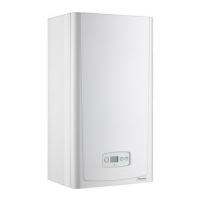
